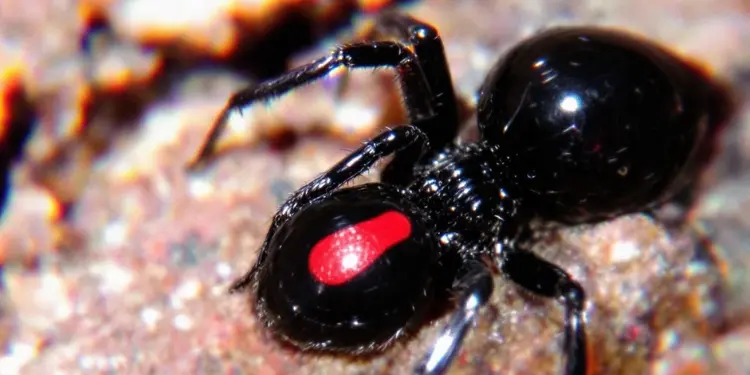Redback spiders male vs. female determination often perplex people. Many are unaware of the differences between males and females. Understanding redback spider male vs female distinctions is essential for comprehending their mating behaviors.
This blog will explain their distinctive characteristics and mating practices. We’ll explore the intriguing world of redback spiders.
Key Takeaways
- Female redback spiders are much bigger than males, growing up to 1 cm long, while males only reach 3-4 mm.
- Male redbacks often die during mating, with about 66% eaten by females in a process called sexual cannibalism.
- Female redbacks can make 4-10 egg sacs, each with about 250 eggs, meaning one female can produce up to 2,500 baby spiders.
- Males that get eaten during mating father more offspring and mate for longer, helping pass on their genes.
- Redback spiders have spread beyond Australia to places like New Zealand, Japan, and Belgium, often living in urban areas.

Physical Differences Between Male and Female Redback Spiders

Moving from the introduction, let’s examine how male and female redback spiders differ. Size is the most apparent difference between them. Female redbacks are significantly larger than males.
A female can grow up to 1 cm long, about the size of your fingernail. Males are considerably smaller in comparison, reaching only 3-4 mm in length. That’s less than half the size of females!
Life span is another significant difference. Female redbacks can live for 2-3 years, while males have much shorter lives, lasting only 6-7 months. This size and age gap plays a crucial role in their mating behaviour.
The small male must be extremely cautious when approaching the larger, longer-lived female. These physical characteristics shape their unique mating habits, which we’ll explore next.
Unique Traits of Male Redback Spiders
Male redback spiders possess unique characteristics. They are significantly smaller than females and have a short lifespan of only a few months. These spiders have two specialised structures called palps, which they use for mating.
Interestingly, once they have used both palps, they become unable to mate again. Some males attempt to mate with immature females who are not yet ready for reproduction.
Mating is dangerous for male redbacks. They often perish during or after copulation. Approximately 66% of males are consumed by the female after mating, a phenomenon known as sexual cannibalism.
Males appear to accept this outcome. They even perform a specific ‘somersault’ movement during mating that positions them close to the female’s mouth. This unusual behaviour aids in ensuring their genetic material is passed on, even if they do not survive the encounter.
Mating Rituals and Behaviours
Redback spider mating is a dangerous process. Males begin by plucking the female’s web to indicate their readiness to mate. They then perform a specific dance to attract her. If she approves, the male will mount her back.
During mating, he positions himself near her fangs! This unusual behaviour allows him to mate for a longer duration. However, it’s a perilous act. Approximately 1 in 10 males survive the encounter.
Female redbacks can be selective. They frequently consume males before, during, or after mating. Some fortunate males manage to mate multiple times. Females can store sperm for up to two years, reducing their need for frequent mating.
After mating, they produce numerous eggs. Each sac can contain about 250 baby spiders! Sexual cannibalism plays a significant role in redback spider mating.
Role of Sexual Cannibalism
Sexual cannibalism is a significant aspect of redback spider mating. Female redbacks consume males after or during mating in approximately 66% of encounters. This behaviour, while seemingly unusual, contributes to increased reproductive success for males.
Research by Dr. Marie Herberstein demonstrates that males consumed during mating father more offspring. They also engage in longer mating sessions, improving their chances of success.
This behaviour has developed over time to benefit the species’ survival.
Cannibalism during mating serves a purpose beyond nutrition for female redbacks. It is an essential component of their reproductive process. Males that offer themselves as food provide females with additional energy for egg production.
This strategy enhances the likelihood of passing on their genes to future generations. Research conducted by Dr. Mark Elgar shows that consumed males father twice as many offspring compared to those that survive mating.
Despite its apparent harshness, this behaviour contributes to maintaining redback spider populations in their natural habitats.
Comparative Analysis: Redback Spider Male vs Female
Moving from the role of sexual cannibalism, let’s compare redback spiders with their close cousins, black widows. Both spiders belong to the genus Latrodectus and have potent venom.
The redback spider is native to Australia, while black widows are found in the Americas. These arachnids share a key trait – they both produce a powerful neurotoxin called alpha-latrotoxin.
Despite their similarities, redback spiders have distinctive mating habits. Male redbacks often sacrifice themselves during mating, a behaviour not observed in black widows. This self-sacrifice aids in passing their genes to the next generation.
Both species are recognised for their striking appearance and web-building abilities. However, the redback’s mating ritual distinguishes it in the spider world, making it an intriguing subject for spider enthusiasts and scientists alike.
Supplementary Insights on Redback Spider Mating
Redback spiders have distinctive mating behaviours that differentiate them from other arachnids. These behaviours include sexual cannibalism and male sacrifice. To discover more about these intriguing creatures, continue reading!
Common Habitats and Distribution
Redback spiders inhabit various regions across Australia. They prefer dark, dry areas for shelter. They are commonly found beneath rocks, inside logs, or in sheds. These spiders also adapt well to urban environments.
They have established habitats in toilets and other city locations re: Redback Spider Male vs Female.
These adaptable spiders have expanded their range beyond Australia. They are now present in New Zealand, Japan, and even Belgium. They have also established populations in the UAE, India, and the Philippines.
Redback spiders flourish in areas where human activity has altered the landscape. This enables them to discover new habitats and increase their population.
Impact of Mating Behavior on Population
Moving from where redback spiders live, let’s examine how they breed. Redback spider mating habits significantly influence their population. Female redbacks produce numerous eggs – 4 to 10 egg sacs with about 250 eggs each.
This means one female can produce up to 2,500 baby spiders!
Male redbacks have short lifespans and prioritise finding suitable mates. They are frequently consumed after mating, which reduces their numbers. This behaviour, however, aids in passing on strong genes to the next generation of spiders.
This combination of high offspring production and low male survival maintains stable redback spider populations in the wild.
Comparison Table: Male vs. Female Redback Spiders
Redback spiders exhibit clear differences between males and females. These differences influence their mating habits and survival. Here’s how male and female redbacks compare:
| Feature | Female Redback Spider | Male Redback Spider |
|---|---|---|
| Size | ~1 cm (0.4 in) | 3–4 mm (0.12–0.16 in) |
| Lifespan | 2–3 years | 6–7 months |
| Venom | ~0.08–0.10 mg | Less strong due to small fangs |
| Reproduction | 4–10 egg sacs, ~250 eggs each | Can’t make more sperm after using both palps |
| Role in Mating | May eat male after mating | Often dies during or after mating |
| Web Building | Builds large, strong webs | Doesn’t build webs |
| Hunting | Active hunter | Doesn’t hunt, seeks females |
These facts demonstrate how male and female redbacks differ. Their unique traits shape how they mate and live. Examining these details provides insights into these spiders’ world.
Conclusion
Redback spider mating is a dangerous process. Males risk their lives, while females obtain nourishment and genetic material. This unusual behaviour ensures the species’ survival. Nature’s methods can be peculiar, yet effective.
Studying these spiders enhances our understanding of the natural world surrounding us.
FAQs
1. How do Redback Spider Male vs Female differ in size?
Female redbacks are much bigger than males… like, heaps bigger. The girls can grow up to 1 cm long, while the blokes are tiny – only about 3-4 mm. It’s a big difference, mate!
2. What’s the go with Redback Spider Male vs Female mating?
It’s a risky business for the males, I’ll tell ya. The little fellas approach the female’s web carefully, ’cause she might eat ’em! They do a special dance to show they’re not food. If she’s keen, they mate – but often, the female gobbles up her partner after. Tough break!
3. Do male redbacks always cop it during mating?
Not always, but it’s common. Some clever males escape after doing the deed. Others offer themselves up as a snack. It’s a bit grim, but it helps their babies survive. Nature’s wild, eh?
4. How long do they live Redback Spider Male vs Female?
The girls can stick around for up to three years if they’re lucky. But the poor old males? They’re lucky to last a year. Life’s short when you’re a male redback – especially if you’re on the menu!





